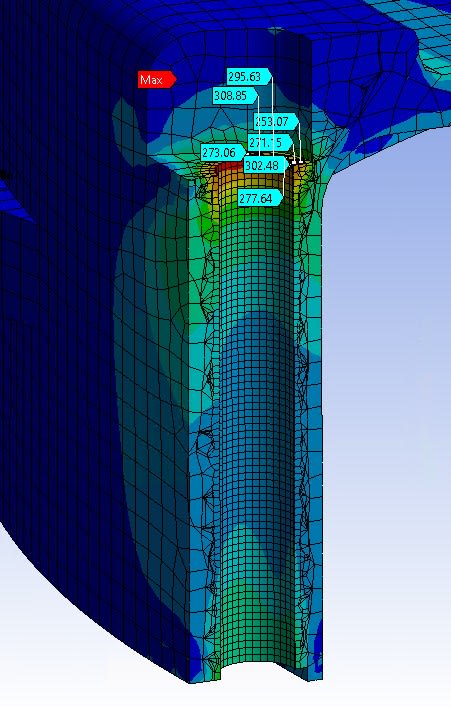Mr_Curious
Mechanical
Hello everyone.
I am designing a machine which has a bolt connection, and there is stress on one of the part under the bolt head, exceeding a yield strength.
The stress is caused by bolt head preload pressure only, because external loads have no influence on the point of interest.
The yield strength is 300 MPa and the max stress on the part is 310 MPa.
Many books say that it is not allowed having a stress above yield strength, whereas I haven't seen any mention about considering a stress under a bolt head.
Searching the internet I've seen that in reality the stress under a bolt head might be much higher due to surface deviation between a head and an opposite surface, also the surface roughness, in which the support does not occur on the entire contact surface but on the tops.
In my case, I can not to use a bigger bolts due to the lace of space and weight limits.
I assume that it is no problem with this place in the future.
I need some advices and thoughts about that please.
Details:
Bolt- M20
Preload force is- 118kN.
Bolt surface area is- 0,000386m2
The result is- 305 MPa.
FEA analysis result is attached:
I am designing a machine which has a bolt connection, and there is stress on one of the part under the bolt head, exceeding a yield strength.
The stress is caused by bolt head preload pressure only, because external loads have no influence on the point of interest.
The yield strength is 300 MPa and the max stress on the part is 310 MPa.
Many books say that it is not allowed having a stress above yield strength, whereas I haven't seen any mention about considering a stress under a bolt head.
Searching the internet I've seen that in reality the stress under a bolt head might be much higher due to surface deviation between a head and an opposite surface, also the surface roughness, in which the support does not occur on the entire contact surface but on the tops.
In my case, I can not to use a bigger bolts due to the lace of space and weight limits.
I assume that it is no problem with this place in the future.
I need some advices and thoughts about that please.
Details:
Bolt- M20
Preload force is- 118kN.
Bolt surface area is- 0,000386m2
The result is- 305 MPa.
FEA analysis result is attached:

